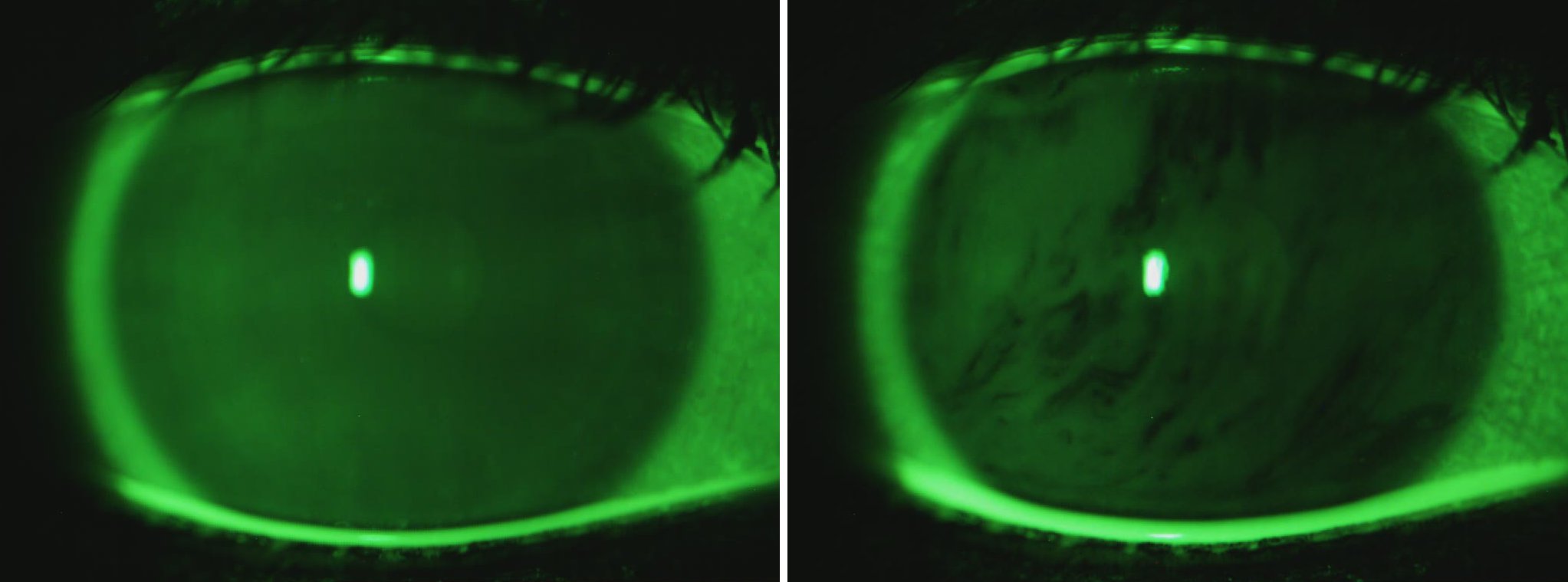[Before Monday] Dry Eye Syndrome
In 1933, the Swedish ophthalmologist H. Sjogren first described dry eye syndrome with the same name Sjogren syndrome (an autoimmune disease in which the secretion of salivary, lacrimal, and other glands is reduced). This is the so-called primary dry eye syndrome, which occurs in 1% of the population. The development of modern technologies has allowed in 1995 to allocate the secondary syndrome of "dry eye" which, according to various sources, affects up to 20% of the population, and up to 48% of office workers.
When we blink, we not only wet the cornea with a tear, but also leave a “tear film” on it. Normally, it persists on the eye for 10 to 45 seconds, then it bursts. We blink again and the process repeats.

')
Each layer of the tear film is very important: lipid prevents evaporation and keeps it on the cornea, water - moisturizes, nourishes the cornea, provides immune protection, mucin layer - reduces the surface tension of tears. Impaired production of one of the components of the tear film affects its quality. She begins to burst faster, there is a feeling of discomfort and symptoms of "dry eye".
The main causes of dry eye syndrome:
Symptoms:
Schirmer test
The essence of the test is simple: a strip of filter paper is laid over the lower eyelid of the eye, which is 5 minutes behind the eyelid. The amount of tear that stands out from the eye stains the paper. According to how long the test strip is painted, the doctor determines the production of tears. Cons: If you perform the test without anesthetic, the test strip will irritate the eye and cause falsely increased tear production. Pain relief, on the contrary, will reduce tear production. The test looks like this:

Study of the tearing time of the tear film
Fluorescein is dripped into the eye and under the blue filter of the microscope they mark the time that the tear film holds on the eye. Norm more than 10 seconds.

Cornea staining
The cornea is stained with Bengal pink, lissamine green or fluorescein to determine dead cells or tear film defects.
Osmolar tear test
With a high osmolarity of tears, a “pulling” of the liquid from the corneal surface epithelium occurs.
Interferometry
Allows you to obtain data on the lipid component of the tear film.
The treatment consists of the normalization of the mode of operation (vision hygiene) and the selection of the necessary drops (artificial tears). Drops should pick up the doctor, depending on what causes the dryness of the eyes and the violation of which layer of the tear film is broken.
Visual hygiene is not difficult to observe: when working at a computer, take breaks every 40 minutes for 5 minutes and hold an eye gymnastics, the techniques of which can be found on the Internet a lot. Here is one of them:

What is this disease?
When we blink, we not only wet the cornea with a tear, but also leave a “tear film” on it. Normally, it persists on the eye for 10 to 45 seconds, then it bursts. We blink again and the process repeats.

')
Each layer of the tear film is very important: lipid prevents evaporation and keeps it on the cornea, water - moisturizes, nourishes the cornea, provides immune protection, mucin layer - reduces the surface tension of tears. Impaired production of one of the components of the tear film affects its quality. She begins to burst faster, there is a feeling of discomfort and symptoms of "dry eye".
The main causes of dry eye syndrome:
- pathology of meibomian glands (produce a lipid layer of the tear film)
- rare blinking (when working at a computer, we blink 5-6 times less)
- use of contact lenses
- use of certain drugs (for example, isotretinoin reduces the secretion of the lacrimal glands)
- eye diseases (eg allergic conjunctivitis)
- vitamin A deficiency
- and many others
Symptoms:
- Foreign body sensation
- Redness
- Feeling of dryness
- Tearing (if not paradoxically, again due to reflex secretion)
- Photophobia
- Itching
- Vision "in the fog"
Research
Schirmer test
The essence of the test is simple: a strip of filter paper is laid over the lower eyelid of the eye, which is 5 minutes behind the eyelid. The amount of tear that stands out from the eye stains the paper. According to how long the test strip is painted, the doctor determines the production of tears. Cons: If you perform the test without anesthetic, the test strip will irritate the eye and cause falsely increased tear production. Pain relief, on the contrary, will reduce tear production. The test looks like this:

Study of the tearing time of the tear film
Fluorescein is dripped into the eye and under the blue filter of the microscope they mark the time that the tear film holds on the eye. Norm more than 10 seconds.

Cornea staining
The cornea is stained with Bengal pink, lissamine green or fluorescein to determine dead cells or tear film defects.
Osmolar tear test
With a high osmolarity of tears, a “pulling” of the liquid from the corneal surface epithelium occurs.
Interferometry
Allows you to obtain data on the lipid component of the tear film.
Treatment
The treatment consists of the normalization of the mode of operation (vision hygiene) and the selection of the necessary drops (artificial tears). Drops should pick up the doctor, depending on what causes the dryness of the eyes and the violation of which layer of the tear film is broken.
Visual hygiene is not difficult to observe: when working at a computer, take breaks every 40 minutes for 5 minutes and hold an eye gymnastics, the techniques of which can be found on the Internet a lot. Here is one of them:

Source: https://habr.com/ru/post/448082/
All Articles